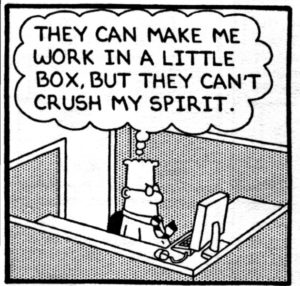Yoga ball or office chair? Cubicle or open plan?
What is your preference?
Complete a super quick, quite fun survey for a chance to win $100.

Some employers have redesigned their previously cubicled offices into open offices with common workspaces. The idea behind this move is to facilitate collaboration and creativity and to make productivity transparent.
In many ways, though, cubicles have gotten a bad rap. Of course, there are instances of employees feeling confined to their “boxes” at work. Such feelings of restriction and confinement, however, is more a matter of stringent office policies than how space itself is experienced. Cubicles can, in fact, serve as a catalyst for all of the creativity that you want to see in the workplace.
Cubicles Increase Productivity Via Privacy
Some employers believe that seclusion leads to idleness. The reality, however, is that employees tend to get more done when they are left to get on with their work without being interrupted or distracted.
Cubicles Are Ideal For Storage
There is little worse than a cluttered office. All of your efforts to accomplish your daily tasks with speed and efficiency are thwarted every time you have to search for a document. Cubicles come with the option of built-in storage areas, which can help improve filing systems and thereby lead to more work completed in a day.
The Best of Both Worlds: Mini Breaks In Shared Spaces
As a way to mitigate the potential feeling of confinement that some people might experience in a cubicle, a company can make sure that there are enough comfortable common spaces that people can move to when they feel the need to take a break. This idea of getting up after a block or work, taking a walk, moving around and doing something completely different than the task at hand is consistent with the observation that people work better when they focus for a while and then take a break before coming back to their work
Cubicles Improve Communication
Another misconception of cubicles is they create barriers that inhibit communication. In reality, though, “boxes” on the work floor actually increase healthy connection. Open areas often lack structure, which leads to disorganization. Employees working on a project may find themselves on opposite sides of the spectrum when seating options are unlimited.
If there is an assigned seating chart as often implemented with cubicle spaces, however, there is a greater possibility of all members of a team working being seated in close quarters. The result is ultimately increased productivity.
Office Innovations, Inc. has helped hundreds of companies create workspaces that increase productivity and engagement and overall well-being. Contact us today for a consultation.